Showcasing Green Infrastructure Innovation on Vancouver Island: The 2008 Capital Region Series
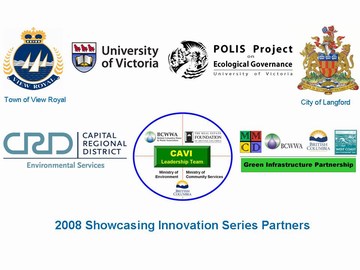
CAVI announces partnership with CRD to deliver program that builds capacity for Climate Change Adaptation
Each event starts with a meet-and-greet at 8:30am, and typically concludes around 2:30pm after a walkabout. Complete details, including how to register, will be progressively provided in separate web stories leading up to each event. For an overview of the 2008 program, including dates, please click here.
Doing Business Differently
Building on the interest and momentum generated by successful series on both sides of the Georgia Basin in 2007, CAVI – Convening for Action on Vancouver Island is collaborating with the Capital Regional District and the Green Infrastructure Partnership to organize Showcasing Green Infrastructure Innovation in the Capital Region: The 2008 Series. To download a program overview and synopsis of each event in the series, please click here.
To learn more about the 2007 program, click on this link to Vancouver Island Showcasing Green Infrastructure Innovation Series a success – 2007 program resonates. The series of three events attracted local governments and other stakeholders from Campbell River south to Victoria.
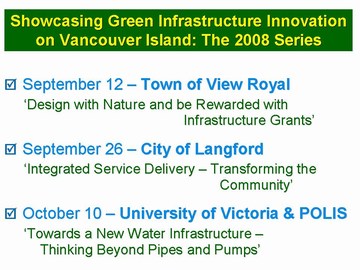
Creating Awareness
According to John Finnie, CAVI Chair (and General Manager, Environmental  Services, Regional District of Nanaimo), “The goal of the Series is to promote networking, inform and educate practitioners, and help local governments move ‘from awareness to action’ in doing business differently — The New Business As Usual — through sharing of approaches, tools, experiences and lessons learned that will ultimately inform a pragmatic strategy for climate change adaptation.”
Services, Regional District of Nanaimo), “The goal of the Series is to promote networking, inform and educate practitioners, and help local governments move ‘from awareness to action’ in doing business differently — The New Business As Usual — through sharing of approaches, tools, experiences and lessons learned that will ultimately inform a pragmatic strategy for climate change adaptation.”
“There are a lot of good things happening throughout Vancouver Island. Yet practitioners in local government are not necessarily aware when they are being innovative and are not often aware of innovation in other municipalities,” continues John Finnie, “Because people are so busy in their own worlds, it takes a third party to connect them. That is the role that CAVI plays.”
A Unique Forum
 “The Showcasing Innovation Series creates pride and enables local governments to tell their stories in a way that no other forum currently provides,” observes Kim Stephens, Series organizer and event Moderator, and Program Coordinator for the Water Sustainability Action Plan for British Columbia. The CAVI program is organized under the umbrella of the Action Plan.
“The Showcasing Innovation Series creates pride and enables local governments to tell their stories in a way that no other forum currently provides,” observes Kim Stephens, Series organizer and event Moderator, and Program Coordinator for the Water Sustainability Action Plan for British Columbia. The CAVI program is organized under the umbrella of the Action Plan.
According to Kim Stephens, “A Showcasing Innovation event is not a conference. Neither is it a workshop nor seminar in the conventional sense. Rather the purpose of the presentations is to whet the appetites of participants for the site tour that follows. The quality one-on-one conversations take place on the bus and when we go for a walkabout.”
Building on Success
 “Starting in 2006, the Showcasing Green Infrastructure Innovation Series has helped local government practitioners immeasurably by creating forums for them to share their experiences and lessons learned. This has created a ripple effect that has spurred even more innovation,” states Ray Fung, Chair of the Green Infrastructure Partnership.
“Starting in 2006, the Showcasing Green Infrastructure Innovation Series has helped local government practitioners immeasurably by creating forums for them to share their experiences and lessons learned. This has created a ripple effect that has spurred even more innovation,” states Ray Fung, Chair of the Green Infrastructure Partnership.
“The 2008 Capital Region Series has created an opportunity for CAVI to build on the foundation provided by last year’s successes, and play an integrating role to cut across disciplines and ultimately help communities create neighbourhoods that integrate both good planning and innovative engineering designs, for overall greater sustainability.” To learn more about the Green Infrastructure Partnership, please click here.
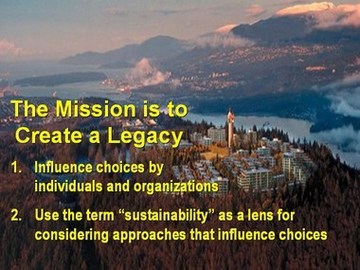
Showcasing Innovation in the Town of View Royal: ‘Design with Nature and be Rewarded with Infrastructure Grants’
The Town of View Royal will showcase its Transportation Master Plan, with the spotlight on the implementation strategy for reconstruction and enhancement of the old Island Highway in phases. “Through a comprehensive consultation process, the community has embraced a holistic, ecosystem approach that looks for opportunities and synergies to 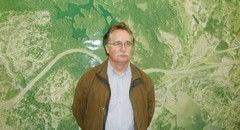 achieve multiple objectives when replacing and/or retrofitting municipal infrastructure. A desired outcome is a liveable community that is in harmony with nature,” reports Emmet McCusker, Director of Engineering.
achieve multiple objectives when replacing and/or retrofitting municipal infrastructure. A desired outcome is a liveable community that is in harmony with nature,” reports Emmet McCusker, Director of Engineering.
“In 2007, the Town’s vision and innovation was rewarded by a $7.4 million grant to fund the first phase of the old Island Highway project,” continues Emmet McCusker. “A driver is restoration of water quality in Portage Inlet, often described as the jewel of Victoria.”
The project achieves five of six elements of a Design with Nature strategy. Furthermore, this regional precedent demonstrates what is meant by The New Business As Usual, establishes new and higher expectations for an environmental approach to infrastructure design, and sets a provincial benchmark for other municipalities to measure themselves against when applying for senior government funding.
 “The Town will share its Grant Application Template so that others can benefit from this successful precedent,” advises Emmet McCusker. “The Town will also present its vision for a regional fibre optic network owned by local government. This would create opportunities for local government to generate new revenue streams”.
“The Town will share its Grant Application Template so that others can benefit from this successful precedent,” advises Emmet McCusker. “The Town will also present its vision for a regional fibre optic network owned by local government. This would create opportunities for local government to generate new revenue streams”.
The old Island Highway project includes installation of a duct for a possible future fibre optic cable. This illustrates what can be done “While We’ve Got that Road Dug Up”.
Showcasing Innovation in the City of Langford:‘Integrated Service Delivery – Transforming the Community’
The City of Langford will showcase the Westhills Green Community which will comprise  6000 new residential units at full build-out. “Because it was one of the first Canadian pilots for LEED Neighbourhood Development, Westhills will help set a new national standard for community development that achieves objectives for socially and environmentally sustainable design,” reports John Manson, City Engineer. “The Westhills plan addresses all six elements of a Design with Nature strategy.”
6000 new residential units at full build-out. “Because it was one of the first Canadian pilots for LEED Neighbourhood Development, Westhills will help set a new national standard for community development that achieves objectives for socially and environmentally sustainable design,” reports John Manson, City Engineer. “The Westhills plan addresses all six elements of a Design with Nature strategy.”
 “The City will also introduce its vision for implementing an ‘integrated utility’ for domestic, reclaimed water, and energy,” adds Graeme Bethell of the CAVI Leadership Team. “A water recycling system and a renewable energy system are at the heart of the plan to achieve the goal of energy self-sufficiency.”
“The City will also introduce its vision for implementing an ‘integrated utility’ for domestic, reclaimed water, and energy,” adds Graeme Bethell of the CAVI Leadership Team. “A water recycling system and a renewable energy system are at the heart of the plan to achieve the goal of energy self-sufficiency.”
“The renewable energy system will be based on geo-exchange, with other technologies being options for the future; and the whole process is central to  assisting the City to become carbon-neutral by 2012,” explains John Manson. “Reclaimed water is proposed to be provided by a new sewage treatment plant that will be located in the vicinity.”
assisting the City to become carbon-neutral by 2012,” explains John Manson. “Reclaimed water is proposed to be provided by a new sewage treatment plant that will be located in the vicinity.”
Looking to the future, a Langford ‘integrated utility’ could potentially create a business opportunity for the City to generate revenue streams that lessen its reliance on traditional sources of local government financing.
In addition to Westhills and the Integrated Utility, the City will also elaborate on its approach to managing risk, learning by doing, and adapting. “This will be illustrated by the City’s long-term approach to rainwater management, and will include a case study example: a new type of pervious paver that has a cobble finish and is designed for H20 traffic loading is being evaluated through a pilot project; the cobble paver is the proposed surface for a planned Quebec City-style Ring Road in the downtown core,” explains John Manson.
Showcasing Innovation at the University of Victoria: ‘Towards a New Water Infrastructure – Thinking Beyond Pipes and Pumps’
Situated at the headwaters of Bowker Creek, the University of Victoria, a community of more than 25,000 people, is a case study for green buildings and compact growth. According to Sarah Webb of the Office of Campus Planning and Sustainability at UVic , “The primary focus of the day will be on the built environment and implementing approaches and practices that achieve a Design with Nature outcome, and reduce physical impacts resulting from intensive urbanization.”
, “The primary focus of the day will be on the built environment and implementing approaches and practices that achieve a Design with Nature outcome, and reduce physical impacts resulting from intensive urbanization.”
The University and POLIS Project will showcase how each is ‘walking the talk’ in turning theory into action; also, POLIS will elaborate on how it is engaging local governments in discussions about new strategies for achieving the goal of sustainable water management and reduced ‘hydrologic footprints’.
 “Emphasis will be on how water sustainability can be achieved through the ‘soft path’ for water and complemented by green infrastructure practices that flow from a Design with Nature guiding philosophy; especially when those infrastructure practices reflect a full and proper understanding of the relationship between land and water,” reports Oliver Brandes, Associate Director of POLIS.
“Emphasis will be on how water sustainability can be achieved through the ‘soft path’ for water and complemented by green infrastructure practices that flow from a Design with Nature guiding philosophy; especially when those infrastructure practices reflect a full and proper understanding of the relationship between land and water,” reports Oliver Brandes, Associate Director of POLIS.
 “The workshop will cascade in three major sections: education (with a focus on broader social and cultural contexts that shape attitudes and behaviour), engagement (taking research into the community) and decisions (making it work on campus). This will be followed by a walkabout to inspect green buildings and green infrastructure at UVic,” adds Susanne Porter-Bopp, Community Water Coordinator with POLIS.
“The workshop will cascade in three major sections: education (with a focus on broader social and cultural contexts that shape attitudes and behaviour), engagement (taking research into the community) and decisions (making it work on campus). This will be followed by a walkabout to inspect green buildings and green infrastructure at UVic,” adds Susanne Porter-Bopp, Community Water Coordinator with POLIS.
“A sit down lunch will be served in the University Club,” concludes Sarah Webb.

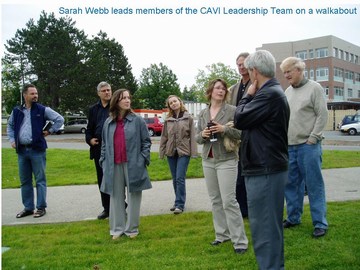
Who is CAVI?
The CAVI Partnership comprises the British Columbia Water & Waste Association, the Real Estate Foundation of British Columbia, the provincial Ministries of Environment and Community Services, and the Green Infrastructure Partnership.
CAVI is co-funded by the Province and the Real Estate Foundation of British Columbia. The Water Sustainability Committee of the BCWWA is the managing partner and is providing program delivery.

Green Vocabulary
To help advance a new way-of-thinking about land development, CAVI has developed and is promoting use of the following hierarchy of ‘green’ vocabulary:
- Green Value means land use strategies will accommodate settlement needs in practical ways while protecting the ecological resources upon which communities depend. At the heart of a Green Value approach is the valuation methodology that provides the business case for reconciliation of short-term versus long-term thinking related to risk and profit.
- Design with Nature is one approach to achieve Green Value, and is supportive of community goals that relate to building social capacity.
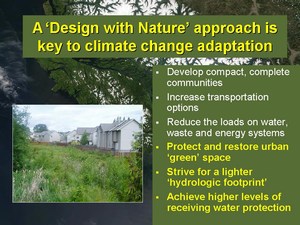
- Green Infrastructure is the on-the-ground application of Design with Nature standards and practices.
- Water Sustainability is achieved through Green Infrastructure practices that reflect a full and proper understanding of the relationship between land and water.
This cascading vocabulary was unveiled at the Creating Our Future Workshop that was held in conjunction with the Gaining Ground Summit in Victoria in June 2007. The Creating Our Future Workshop was a consultation opportunity for Vancouver Island local governments that are interested in implementing green infrastructure practices and legislation that result in green value.
Posted June 2008

